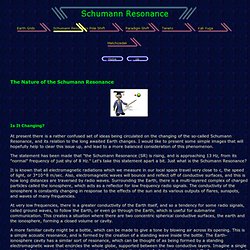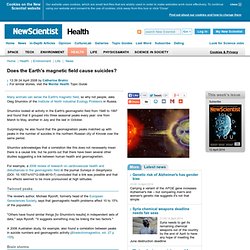

Icists investigate the role of quantum entanglement in the magnetic compasses of animals. (PhysOrg.com) -- Many animals possess some kind of magnetic sense, allowing them to navigate by using a magnetic field.

Biogenic Magnetite. Iron Biomineralization in the Human Brain Follow this link to read some abstracts of publications from this project.

Biomineralization of ferrimagnetic magnetite is known to occur in a number of organisms including animals [e.g. 1]. 7683.full.pdf (application/pdf Object) Magnetoreception & Sensing Earth's Magnetic Fields. Humans may have a sixth sense after all, suggests a new study finding that a protein in the human retina, when placed into fruit flies, has the ability to detect magnetic fields.

The researchers caution that the results suggest this human protein has the capability to work as a magnetosensor; however, whether or not humans use it in that way is not known. "It poses the question, 'maybe we should rethink about this sixth sense,'" Steven Reppert, of the University of Massachusetts Medical School, told LiveScience. "It is thought to be very important for how animals migrate. Perhaps this protein is also fulfilling an important function for sensing magnetic fields in humans. " Past research has suggested that in addition to helping animals such as sea turtles and migratory birds navigate, the ability to detect magnetic fields could help with visual spatial perception. Animals' magnetic sense is thought to rely on special proteins called cryptochromes, which are also found in the human retina.
Humans have a magnetic sensor in our eyes, but can we detect magnetic fields? Many birds have a compass in their eyes.

Their retinas are loaded with a protein called cryptochrome, which is sensitive to the Earth’s magnetic fields. It’s possible that the birds can literally see these fields, overlaid on top of their normal vision. This remarkable sense allows them to keep their bearings when no other landmarks are visible. But cryptochrome isn’t unique to birds – it’s an ancient protein with versions in all branches of life. In most cases, these proteins control daily rhythms. Foley worked with Drosophila flies, which can normally sense magnetic fields using cryptochome.
To restore their internal compass, Foley simply has to give the mutant flies extra copies of cry. These simple experiments show that human cryptohrome can act as a magnetic sensor. A radical idea The connections between light, cryptochrome and a magnetic sense were laid out by Klaus Schulten and Thorsten Ritz in 2000, in a bravura paper that united biology and quantum physics.
Humans could have geomagnetic sight. The ability to see Earth's magnetic field, thought to be restricted to sea turtles and swallows and other long-distance animal navigators, may also reside in human eyes.

Tests of cryptochrome 2, a key protein component of geomagnetic perception, found that its human version restored geomagnetic orientation in cryptochrome-deficient fruit flies. Flies are a long, long way from people, but that the protein worked at all is impressive. There's also a whole lot of it in our eyes. "Could humans have this cryptochrome heavily expressed in the retina as a light-sensitive magnetoreceptor? " said University of Massachusetts neuroscientist Steven Reppert, lead author of a 21 June Nature Communications cryptochrome study. Reppert, whose laboratory specialises in the biological mechanisms underlying long-distance butterfly migration, showed three years ago that cryptochrome allowed fruit flies to geomagnetically orient themselves using light.
Source: Wired.com. The tiny magnetite compass in the human nose. Scientists discover moral compass in the brain which can be controlled by magnets. By David Derbyshire Updated: 10:52 GMT, 30 March 2010 The moral compass, technically named the right temporo-parietal junction, lies just behind the right ear in the brain Scientists have discovered a real-life 'moral compass' in the brain that controls how we judge other people's behaviour.

The region, which lies just behind the right ear, becomes more active when we think about other people's misdemeanours or good works. In an extraordinary experiment, researchers were able to use powerful magnets to disrupt this area of the brain and make people temporarily less moral. The study highlights how our sense of right and wrong isn't just based on upbringing, religion or philosophy - but by the biology of our brains. Dr Liane Young, who led the study, said: 'You think of morality as being a really high-level behaviour. QBI researchers discover 'inner compass' in the human brain - Queensland Brain Institute (QBI) - The University of Queensland, Australia. If you have ever lost your sense of direction in an unfamiliar place, then researchers at the Queensland Brain Institute may be able to help.

They have discovered that a person’s ability to find their way is learned gradually and that the brain eventually becomes tuned to key landmarks in the new environment. Dr Oliver Baumann, who led the study, had volunteers learn to navigate to landmarks around a computer-generated maze over several days. Magnetism Can Sway Man's Moral Compass. Earth's rhythms, Schumann resonances, magnetic field sensor, Global Coherence Monitoring System. This section explains examples of data obtained from the Global Coherence Monitoring System site located in Boulder Creek, Calif., at the Institute of HeartMath Research Center.

The graphs include examples of time domain signals, frequency spectrums, spectrograms and waterfall plots. The spectrum figures clearly show the various Schumann resonances and how the resonances change over time. In addition, an audio file is included so you can hear what these earth rhythms sound like when shifted into an audible range. You are able to see near real-time updates on the changes occurring in the (click on Live Data) resonances and magnetic fields within the earth’s ionosphere. Figure 1. Earth Changes - The Nature of the Schumann Resonance. The Nature of the Schumann Resonance Is It Changing?

At present there is a rather confused set of ideas being circulated on the changing of the so-called Schumann Resonance, and its relation to the long awaited Earth changes. I would like to present some simple images that will hopefully help to clear this issue up, and lead to a more balanced consideration of this phenomenon. The statement has been made that "the Schumann Resonance (SR) is rising, and is approaching 13 Hz, from its "normal" frequency of just shy of 8 Hz. " Let's take this statement apart a bit. It is known that all electromagnetic radiations which we measure in our local space travel very close to c, the speed of light, or 3*10^8 m/sec.
Does the Earth's magnetic field cause suicides? - health - 24 April 2008. Many animals can sense the Earth's magnetic field, so why not people, asks Oleg Shumilov of the Institute of North Industrial Ecology Problems in Russia.

Shumilov looked at activity in the Earth's geomagnetic field from 1948 to 1997 and found that it grouped into three seasonal peaks every year: one from March to May, another in July and the last in October. Surprisingly, he also found that the geomagnetism peaks matched up with peaks in the number of suicides in the northern Russian city of Kirovsk over the same period. Shumilov acknowledges that a correlation like this does not necessarily mean there is a causal link, but he points out that there have been several other studies suggesting a link between human health and geomagnetism. Twinned peaks.
EMF - Electromagnetic Pollution.